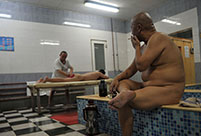 If you like autumn, put your hands in the air!
If you like autumn, put your hands in the air!
 Fan Bingbing's "Queen style" in new play
Fan Bingbing's "Queen style" in new play
 Lingerie show at 2014 Miss China
Lingerie show at 2014 Miss China
 J-10 fighters show aerobatic stunts in smog-free sky
J-10 fighters show aerobatic stunts in smog-free sky
 Charming contestants of Shanghai Int’l Model Contest
Charming contestants of Shanghai Int’l Model Contest
 Most amazing chi-pao beauties
Most amazing chi-pao beauties
 7 deadly animal attacks
7 deadly animal attacks
 Picturesque autumn scenery of Hongshan Army Horse Ranch
Russia to launch 70 Proton rockets by 2020: official
Picturesque autumn scenery of Hongshan Army Horse Ranch
Russia to launch 70 Proton rockets by 2020: officialThe local customs and cultural heritage of the ancient town of Pingyao in Shanxi Province is under threat due to the rapid development of tourism.
In the 17 years since the 2,700-year-old town was added to UNESCO's World Heritage List, it has seen tourism develop at a meteoric pace, with its tourism revenue growing from 12.5 million yuan (2.04 million U.S. dollars) in 1997 to 5.416 billion yuan in 2013.
Business opportunities afforded by the blossoming of tourism has resulted in the transformation of traditional dwellings along the town's main drag into hostels, souvenir shops, eateries and bars.
Many tourists complain that the ancient town is losing its serenity and unique style.
Zhang Peng, an associate professor of architecture with Tongji University in Shanghai, said the future of a heritage site should be based on the collective willingness of all interest groups. However, in Pingyao, local residents often feel disenfranchised.
Every ancient town should find a development pattern that is in accordance with its own characteristics, and the local governments should control commercial activities deemed to be against the traditional characteristic of the town, he said.
Hou Shijun, head of the tourism bureau of Pingyao County, said: "Some businesses may indeed damage the traditional cultural heritage. The government is currently working on the issue of market access, and we should not allow the ancient town to become a cultural hodgepodge."
Unreasonable demographic structure is also a threat to the cultural heritage of Pingyao.
According to county deputy head Hu Jinliang, in 1997 the population of the 2.25-square-kilometer town was 45,000, yet the density was about 16 times of that of Beijing.
In response, the local government has moved many public institutions and enterprises out of town, with the purpose of transforming it from a community to a tourist site.
Local residents have also been leaving the area due to inconvenient transportation and substandard living conditions.
Local resident Gao Guihong said: "It is too humid in the house. There is no big supermarket, school or hospital in the town, and the air is also bad since we still use coal for heating."
Gao, 45, said that in an effort to save enough money to finance a move out of the county, has found work as a waiter in a hostel and is also employed part-time as a masseuse.
Ji Taiping, director of the county's urban-rural planning bureau, said that since the number of local residents emotionally attached to the traditional houses decreased and the number of tourists and newcomers grew the ancient town had begun to slowly lose its vigor and vitality.
The current situation also threatens the protection of traditional structures as this influx of outsiders usually lack any interest in protecting or restoring the houses, Ji said.
The local government should regulate the development of tourism and improve infrastructure and living conditions for local residents, he added.
The county has 3,797 traditional dwellings and other historical sites within its 6.4-km-long walls. But only about 400 are well-preserved and the majority are dilapidated due to a lack of adequate protection, said county chief Cao Zhisheng.
The protection of the buildings in this ancient town should develop alongside improvements for the local residents, Zhang Peng said.
 World Pole Dance Championship in China
World Pole Dance Championship in China In pics: PLA stages live-fire drill in NE China
In pics: PLA stages live-fire drill in NE China  Post-85s female pilots and their mission
Post-85s female pilots and their mission Century-old public bath closes door in Beijing
Century-old public bath closes door in Beijing Shocking! Photos of Chinese fighters revealed
Shocking! Photos of Chinese fighters revealed Images of angels in white: At work v.s off work
Images of angels in white: At work v.s off work  Standard faces for each countries in the world
Standard faces for each countries in the world Netizens fall in love with champion swimmer Ning Zetao
Netizens fall in love with champion swimmer Ning Zetao Vibrant 21-year-old and her own Cheongsam brand
Vibrant 21-year-old and her own Cheongsam brand Top 10 most dangerous jobs in the world
Top 10 most dangerous jobs in the world  Top 10 fifth generation jet fighters in the world
Top 10 fifth generation jet fighters in the world Top 10 Chinese goddesses
Top 10 Chinese goddesses  Top 20 hottest women in the world in 2014
Top 20 hottest women in the world in 2014 Top 10 pure beauties in showbiz
Top 10 pure beauties in showbiz  Top 10 world's highest-paid models 2014
Top 10 world's highest-paid models 2014 The most gorgeous Chinese women
The most gorgeous Chinese women Top 10 most handsome faces in Asia
Top 10 most handsome faces in AsiaDay|Week|Month